There are countless firearms from the 19th century that have become iconic, thanks to their appearance in movies and TV shows. The Winchester Model 1892, thanks in no small part to its appearance in the hands of John Wayne, is largely remembered as a classic Western gun — even if many of its appearances are quite anachronistic. Likewise, the Colt Peacemaker has been seen in hundreds of films.
Then there is a rifle that is a little less familiar to most Americans, yet has become a secret movie star in its own right.
The Martini Henry is a Secret Movie Star
By Peter Suciu
At the end of the 1964 film Zulu, which chronicled the events of the almost infamous frontier outpost of Rorke's Drift along Zululand where approximately 100 British soldiers fended off an attack by some four thousand Zulu warriors, Stanley Baker replies that the victory wasn't merely a miracle, but rather, “a short chamber Boxer Henry .45-caliber miracle.” Whether the real Lieutenant John Chard ever said such a statement is certainly lost to history, but the fact remains that the cartridge and the weapon that fired those bullets played a very decisive role in determining the outcome.

It was the Martini Henry, a single-shot long gun that was arguably the weapon that helped build and maintain the British Empire.

History of the Martini Henry
Introduced in 1853, the Enfield Rifle was a muzzle-loading, rifled musket that had a range of about 1,000 yards. Updated in 1867 as the Snider-Enfield Rifle, it incorporated a breech system that was invented by Jacob Snider of New York. This involved the removal of two inches of the butt end for a breech-loading system utilizing the new brass cartridge ammunition. The space behind the cartridge was closed with an iron breechblock, hinged to the right side of the barrel.
The 1860s and early 1870s were a time of great conflict and the British closely observed the wars around the world including the American Civil War (1861–1865), the Danish-Prussian War (1864), the Austro-Prussian War (1866), and of course the Franco-Prussian War (1870–1871). The adoption of the Prussian needle-gun and the French Chassepot Rifle were indicators that the aging Enfield Rifle needed to be updated. The result was the stopgap Snider-Enfield as an interim measure and made good use of the huge stockpiles of P53s that the British possessed. While these weapons are considered classics to gun collectors today, it was clear to military planners of the day that a suitable replacement was needed.
That replacement would be the Martini-Henry, a rifle that some argue should be properly designated the Peabody-Martini-Henry.

The firearm is a breechloading central-fire weapon, meaning that the cartridge (or bullet) is loaded into a chamber at the rear of the rifle. This enables the soldier to reload quickly and fire more rounds than the previous muzzle loading methods that required that the projectile be loaded down the barrel. A small lever operated and lowered the breechblock, and allowed a cartridge to be inserted into the chamber, which returned the lever to the former position and closed the breech. The breech is centrally pierced to accommodate the firing pin, which was driven forward by pulling the trigger. Lowering the lever would then eject the fired cartridge and a new one could be placed. Thus several more rounds a minute could be fired, and a soldier could remain in the crouched or prone position, which offered a benefit over the traditional muzzle-loading firearm.
The Martini-Henry weighs about nine pounds and is just over four feet in length. It fires a hardened lead bullet with a muzzle velocity of 1,350 feet per second, and the weapon is sighted for up to 1,000 yards. However, it was generally found during the Zulu War that the rifle was only capable of a man-sized target to a range of 400 yards — as the bullet would only travel subsonic after 300 yards and gradually lose speed, impacting both consistency and accuracy.
Unlike the Snider-Enfield it was also the first English service rifle designed as a breechloading rifle. Later versions of the Martini-Henry improved upon the design by incorporating other rifling patterns, including the Metford System and even a system designed by Enfield. These later versions are often referred to as Martini-Enfields and Martini-Metfords.
Becoming a Movie Star
Interestingly, the Martini Henry hadn't been seen in a movie prior to 1964's Zulu, but the gun was called out by name in the film, which told of the true heroic defense of a remote British post at the start of the Zulu War. Some 150 British soldiers from the 24th Regiment of Foot (identified in the film as the South Wales Borderers despite the fact that they weren't called that until two years after the battle) and other colonial troops were able to fend off an attack by some 4,000 Zulus.
The film has been credited for being a fairly accurate depiction of the battle, but due to a shortage of actual rifles, a number of Lee-Enfield Mk I CLLE (Charger Loading Enfields) were used in the final Zulu assault on the Rorke's Drift.
The Martini Henry made another significant appearance in the Zulu prequel Zulu Dawn (1978), which depicted the worst defeat of the British Army in the 19th century at the Battle of Isandlwana on January 22, 1879.
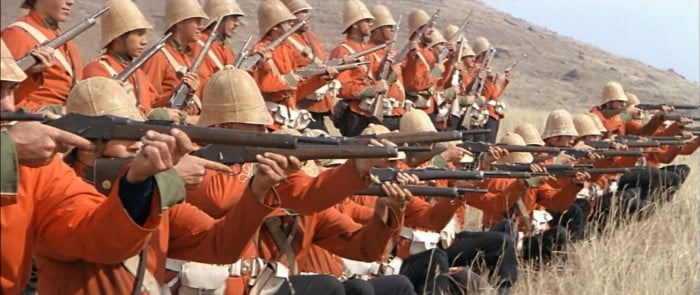
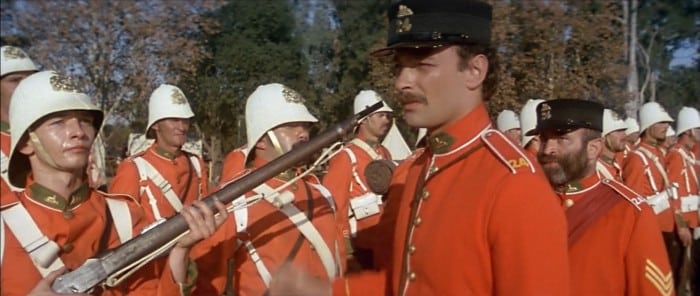
Yet, also likely due to the lack of available Martini Henry rifles for the production, a number of soldiers in the background could be seen carrying Short Magazine Lee-Enfields (SMLE) and even Pattern 1914 Enfields. In addition, many of the infantry soldiers are also incorrectly seen with the Martini-Enfield Carbine instead of the rifle.

Not surprisingly, the famous British firearm has subsequently appeared in a series of jingoistic films that chronicled the British Empire including 1966's Khartoum and The Naked Prey, and later could be seen carried by Simon Ward in Young Winston (1972,), which depicted the exploited of Winston Churchill as a soldier in India and Africa.

It was also seen in such period pieces as Gandhi (1982) and was seen carried by Heath Ledger and Wes Bentley in 2002's The Four Feathers. Martini Henry rifles made an appearance in two films about the Australia bush-ranger and outlaw Edward “Ned” Kelly including 2003's Ned Kelly and 2019's True History of the Kelly Gang. Interestingly while Ledger used the rifle in The Four Feathers, he was never seen with one in Ned Kelly, when he played the title character — yet, George MacKay was armed with one when playing Kelly in the latter film.

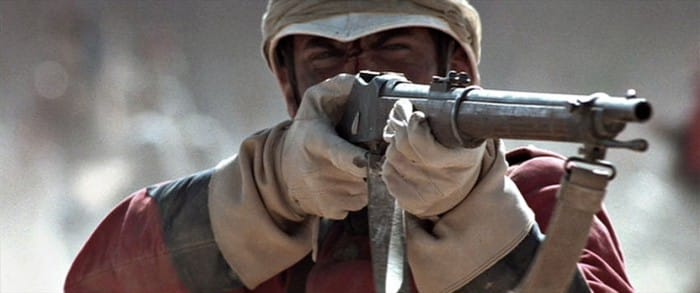
On TV, the rifle was seen in 2016's Rebellion, about the post-World War I Anglo-Irish War, in the 2019 BBC period-correct mini-series The War of the Worlds, and last year in Around the World in 80 Days.
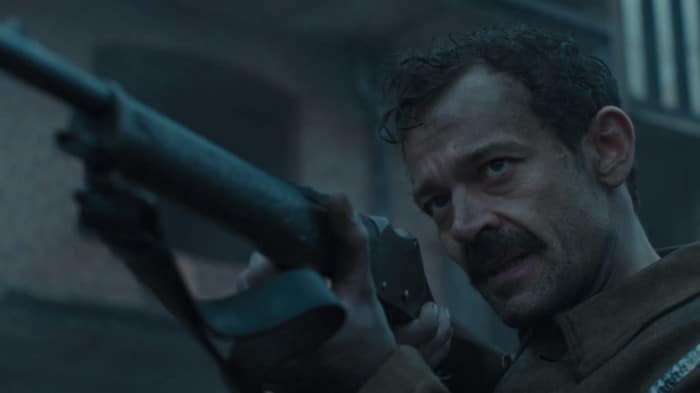
The Man Who Would Be King
Perhaps the most famous use of the Martini Henry was in the 1975 feature The Man Who Would Be King, an adaptation of the 1888 Rudyard Kipling short story. Directed by John Huston, it starred Michael Caine and Sean Connery as two former British Army NCOs, who opted to cross to the remote Afghan region of Kafiristan, where they planned to become kings and get rich in the process.
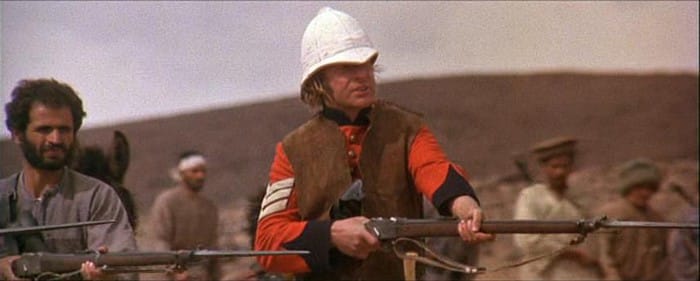
Key to their plan was to smuggle 20 Martini Henry rifles through Afghanistan and to form a small company of soldiers to defeat the largely primitive local warlords.
No mention is ever made of how much ammunition the pair bring with them, but viewers need a fair amount of “suspension of disbelief” to accept that even with mules, it would be a challenge for two men to transport that many rifles and accompanying ordnance!
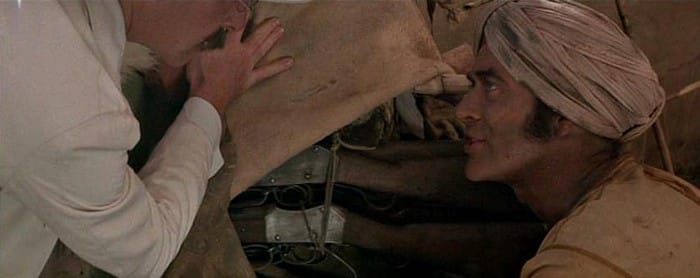
Also worth noting is that Clark Gable and Humphrey Bogart were first considered to play the leads when Huston first tried to make the film. Later Burt Lancaster and Kirk Douglas were suggested, followed by Richard Burton and Peter O'Toole, and in the early 1970s, Huston even approached Robert Redford and Paul Newman. However, Newman suggested that British actors should take on the role — and he even suggested Caine and Connery. Both actors had said it was their favorite of all movies they had worked on.
Sporterized and Modernized Versions
President Teddy Roosevelt, played by Brian Keith, could be seen with a “sporterized” Martini-Henry Mk III in the 1975 adventure film The Wind and The Lion. It has been suggested the rifles would have been specially modified by British gunsmiths Greener or Rigby, as the rifle was known to be quite accurate for its day.
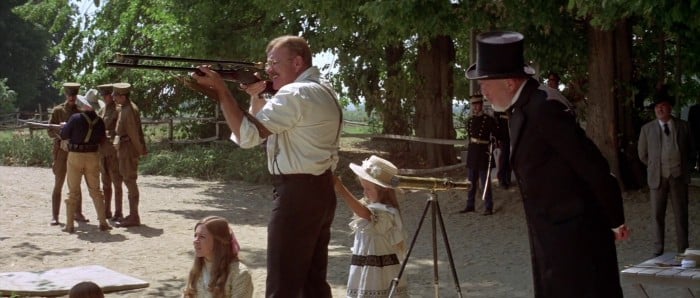
Sporterized Mk IIIs could also be seen in 2010s The Wolfman, and used by both Benicio del Toro and Anthony Hopkins, and a year later in Sherlock Holmes: A Game of Shadows.
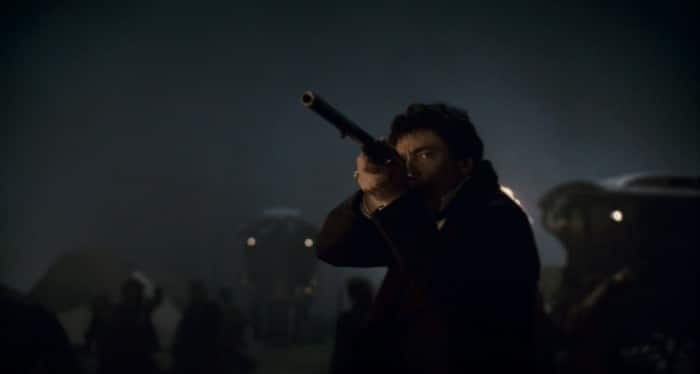
The Martini Henry has also been modified over the years, standing in for a BSA Line Thrower in Traitor's Gate (1964), and later as a W.W. Greener Harpoon Gun used by the Mariner (Kevin Costner) in Waterworld (1995). The prop gun was likely based on the real Harpoon Gun, which was based on the Martini action. One of the real harpoon guns was used by Quint (Robert Shaw) in 1975's Jaws.
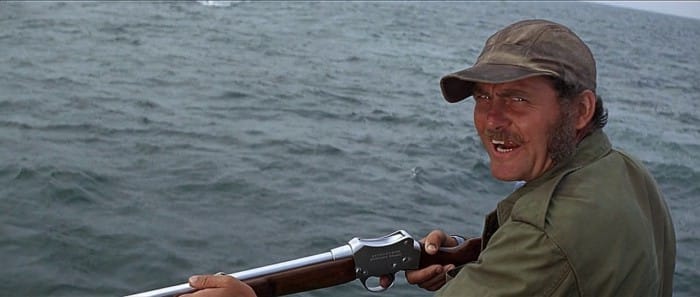
In Video Games
The Martini Henry has become a fan favorite appearing in a number of video games, first appearing in the 2014 hit Assassin's Creed Unity, and then being a “sniper rifle” in 2016's World War I-themed Battlefield 1.

It appeared in the supernatural multiplayer survival horror game Hunt: Showdown and as the Romanian and Bulgarian forces as the Română Arma Md. 1895 (M1879 Peabody-Martini) in the First World War game Tannenberg (2017).
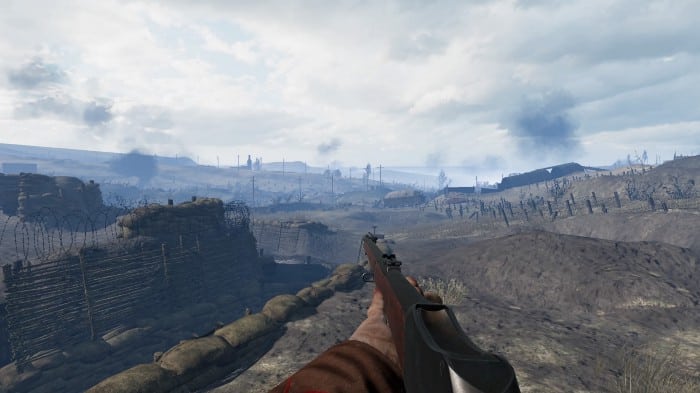
Read the original article in its entirety at medium.com.


Wasnt rifle used in WW1 too aside Enfield??